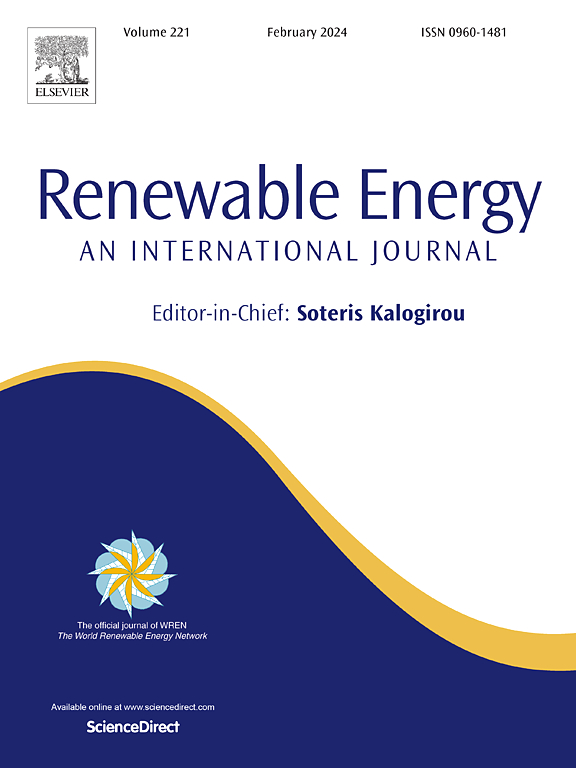State-of-the-art nonstationary hypersurface damage assessment approach for energy harvesters
IF 9
1区 工程技术
Q1 ENERGY & FUELS
引用次数: 0
Abstract
Since EH (Energy Harvesters) constitute nowadays a vital part of renewable energy engineering, experimental research is required in addition to numerical modeling, serving reliable structural design and ensuring prolonged device service time. The performance of GPEH (GalloPing EH) has been examined in this case study, utilizing comprehensive laboratory wind tunnel tests, carried out under realistic windspeed conditions. Novel structural multivariate risks assessment methodology, presented here, being feasible for nonstationary nonlinear GPEH dynamic systems, that had been either physically measured over a representative period, providing jointly quasi-ergodic time-series, or directly numerically MCS (Monte Carlo Simulated). Based on laboratory-measured GPEH dynamics, the presented analysis demonstrates that the proposed multivariate hypersurface methodology offers robust predictions of the structural failure/damage risks. Furthermore, when dealing with raw measured timeseries, representing the high-dimensional dynamic system, existing risk assessment techniques struggle to handle nonlinear inter-correlations between GPEH critical components. This case study's main objective has been to validate and benchmark the novel multimodal risk assessment methodology, which utilizes multivariate nonstationary lab-recorded time histories to extract relevant design information from the underlying GPEH dynamics.
The proposed state-of-the-art nonstationary hypersurface reliability approach being of a generic nature, offering additional capacity for damage/failure risks prognostics for a wide range of nonlinear multidimensional nonstationary systems. Forecasted damage and failure risks have been supplied with confidence bands, demonstrating the experimental setup's robustness, as well as the useful design features of the presented nonstationary hypersurface risks assessment methodology. It should be noted that the presented reliability methodology being mathematically exact, and it does not rely on simplifying assumptions.
最先进的能量收集器非稳态超表面损伤评估方法
由于能量收集器(EH)如今已成为可再生能源工程的重要组成部分,因此除了数值建模之外,还需要进行实验研究,以进行可靠的结构设计,并确保延长设备的使用寿命。本案例研究利用实验室风洞综合测试,在实际风速条件下对 GPEH(GalloPing EH)的性能进行了检验。本文介绍的新型结构多元风险评估方法适用于非稳态非线性 GPEH 动态系统,该系统在一个具有代表性的时期内进行了物理测量,提供了共同的准啮合时间序列,或直接进行了蒙特卡罗模拟(MCS)。基于实验室测量的 GPEH 动力学,所做的分析表明,所提出的多元超曲面方法可对结构失效/损坏风险进行可靠预测。此外,在处理代表高维动态系统的原始测量时间序列时,现有的风险评估技术很难处理 GPEH 关键部件之间的非线性相互关系。本案例研究的主要目的是验证和基准测试新型多模态风险评估方法,该方法利用实验室记录的多变量非稳态时间序列,从 GPEH 基本动态中提取相关设计信息。预测的损坏和失效风险带有置信带,证明了实验装置的稳健性,以及所介绍的非稳态超表面风险评估方法的有用设计特征。值得注意的是,所提出的可靠性方法在数学上是精确的,并不依赖于简化假设。
本文章由计算机程序翻译,如有差异,请以英文原文为准。
求助全文
约1分钟内获得全文
求助全文
来源期刊

Renewable Energy
工程技术-能源与燃料
CiteScore
18.40
自引率
9.20%
发文量
1955
审稿时长
6.6 months
期刊介绍:
Renewable Energy journal is dedicated to advancing knowledge and disseminating insights on various topics and technologies within renewable energy systems and components. Our mission is to support researchers, engineers, economists, manufacturers, NGOs, associations, and societies in staying updated on new developments in their respective fields and applying alternative energy solutions to current practices.
As an international, multidisciplinary journal in renewable energy engineering and research, we strive to be a premier peer-reviewed platform and a trusted source of original research and reviews in the field of renewable energy. Join us in our endeavor to drive innovation and progress in sustainable energy solutions.
 求助内容:
求助内容: 应助结果提醒方式:
应助结果提醒方式:


